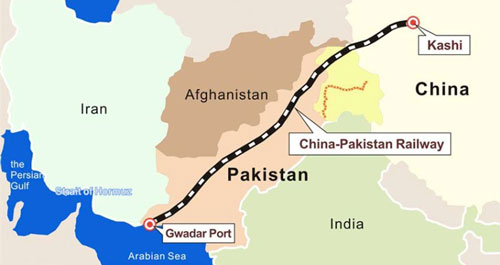Khalid Saleem
TWO subjects – CPEC and ML-1 – have been in the news of late. Both have been discussed extensively for various reasons in the context of bilateral relations between Pakistan and China. A third subject has also been in the news; that is the future of Pakistan Steel Mills: more often than not in the context of whether it has a future worth the name at all! CPEC, needless to stress, is the prospect of the future of this region. If this project lives up to its promise, it is destined to have a profound impact on the future of this region and indeed beyond. Much will depend, of course, on how the projects that it envisages are handled, or mishandled as the case may be. What follows are random thoughts on one of the envisaged projects under the overall umbrella of CPEC. This is not to state that all that all sub-projects it envisages are not as important. What is worth special mention is the fact that the matter of the future of Pakistan Steel Mills, which has been of some doubt of late, assumes added importance when viewed in the light of fresh developments.
Coming now to the res, as legal eagles would put it! News has it that Pakistan is to seek a $2.75 billion Chinese loan for the construction of phase-1 of the ML-I Railway Project under CPEC. This news should provide considerable food for thought. CPEC is a composite project that sets it apart from such others dealt with in the past. So, instead of going by the book, would it not be expedient to explore newer and more avenues of cooperation and dove-tailing than hitherto? Past experience shows that such loans and the resulting projects are rarely utilized to coordinate with the local industry. History is witness that the principal beneficiaries are invariably the industries of the lending country. This need not be so in the case of projects covered by CPEC. Relations between Pakistan and China are of a different hue and at a different level altogether. This needs to be kept in mind and taken advantage of to make this project the harbinger of mutual cooperation between the two countries.
As reported, the new railway line of ML-1 for which the loan is destined is envisaged to cover, among others, the following:
a) Dual carriageway i.e. four lines.
b) It will be 1,800 kilometres long.
c) It will need steel tracks, slippers & nuts, bolts with joining pads all the way.
d) Additionally, the Project will need innumerable signal iron frames, level-crossing-gates and sundry other steel equipment.
As would be obvious, the envisaged project will require an effort of gigantic proportions in so far as the manufacture of the steel components required is concerned. The question that presents itself, begging for an answer is: can China not be asked to establish and energize a special section in Pakistan Steel Mills and to produce the steel items required for project ML-1 in the required huge quantity? Would this not only make economic sense but also help to put PSM back on the rails, so to speak? It might, thereby, lead an effort to put life into one of Pakistan’s most expensive and prestigious projects, lying – tragically and helplessly – idle at the present juncture. Killing two birds with one stone as it were! This should present an idea worth exploring by the powers that be.
What the situation calls for is a determined effort to convince our Chinese friends to utilize to the maximum the engineering industries of Pakistan, and particularly the Pakistan Steel Mills, for making all the steel components of the railway track such as railway line and sleepers, as also for some other components such as nuts and bolts, joining plates. The matter is of some importance. The Pakistan Steel Mills is going through a very critical phase. The ambitious project that was completed with such fanfare is now passing through a crisis that may lead to the shutting down of the project and loss of jobs for its workers. This crisis can be overcome and averted through some high-level diplomacy. If it succeeds would it not be well worth the effort?
In addition to putting the Pakistan Steel Mills to use, smaller industrial units for such components as nuts and bolts, joining plates and other ancillary items, special factories could profitably be put up in Special Engineering Zones on a top priority basis in KP, Karachi, Lahore and Faisalabad. Such factories will have a full workload right from the start. After completion of ML-1, these factories can be used profitably for manufacturing components for Pakistan Railways like their other factories. The proposals in the preceding paragraphs represent an effort at throwing up random ideas for creating links among the various projects being envisaged at the present juncture. A case can justifiably be made for joining the dots, as it were. And why not?










